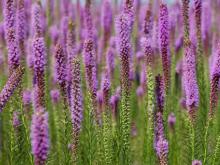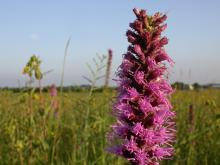Wildflowers, Grasses and Other Nonwoody Plants
Media
Species Types
Scientific Name
Vernonia baldwinii
Description
Ironweeds are tough, grayish-green, branching plants known for their fluffy-looking clusters of reddish-purple florets. They are a familiar sight on roadsides and pastures. Identify western ironweed by the bracts at the base of the flowerheads.
Media

Species Types
Scientific Name
Liatris aspera
Description
Rough blazing star is fairly common and scattered nearly statewide. To distinguish between Missouri’s nine species in the genus Liatris, start by noting details of the flower structure. It’s not hard when you know what to look for.
Media

Species Types
Scientific Name
Liatris pycnostachya
Description
Prairie blazing star has an unbranched stalk with many densely crowded, rose-purple flowerheads. It is a signature wildflower of the tallgrass prairie.
Media

Species Types
Scientific Name
Symphyotrichum spp. (formerly Aster spp.)
Description
Missouri has 24 species of New World asters in genus Symphyotrichum. Most have purple or white ray flowers and yellow disk flowers that turn reddish over time. Most bloom in late summer and fall.
Media

Species Types
Scientific Name
Viola spp.
Description
Violets, as a group, are fairly easy to identify, with their colorful five-petaled “faces” so welcome in springtime. Missouri has 17 species, and some are confusingly similar. This page introduces them as a group.
Media

Species Types
Scientific Name
Viola missouriensis (syn. V. sororia var. missouriensis)
Description
Missouri violet is one of five Missouri stemless violets with purple or blue flowers and unlobed leaves. It is distinguished by its triangular or heart-shaped leaves that are longer than wide and are coarsely toothed only on the basal two-thirds.
Media

Species Types
Scientific Name
Glechoma hederacea
Description
Ground ivy, or creeping Charlie, is a creeping, nonwoody plant that often forms loose mats. A native of Eurasia, this member of the mint family has been introduced nearly throughout the United States. It is considered a lawn and garden weed.
Media

Species Types
Scientific Name
Penstemon cobaea
Description
Cobaea beardtongue, or purple beardtongue, is probably Missouri’s showiest species of penstemon. Native to Missouri's southern Ozarks, it is grown statewide for its beauty, and because pollinators like it. It may be purple or white.
Media

Species Types
Scientific Name
Vernonia missurica
Description
Missouri ironweed is one of Missouri’s five species of ironweeds. Most common in the eastern half of the state, it is a hairy ironweed with a relatively large number of florets per flowerhead.
Media

Species Types
Scientific Name
Liatris spp.
Description
Missouri boasts nine native species of blazing stars, or gayfeathers, in genus Liatris. These showy, upright, unbranching spikes of magenta-pink wildflowers bloom in sunny habitats.
See Also
About Wildflowers, Grasses and Other Nonwoody Plants in Missouri
A very simple way of thinking about the green world is to divide the vascular plants into two groups: woody and nonwoody (or herbaceous). But this is an artificial division; many plant families include some species that are woody and some that are not. The diversity of nonwoody vascular plants is staggering! Think of all the ferns, grasses, sedges, lilies, peas, sunflowers, nightshades, milkweeds, mustards, mints, and mallows — weeds and wildflowers — and many more!





















